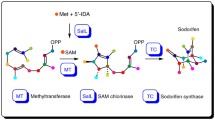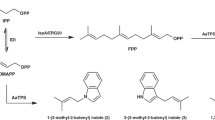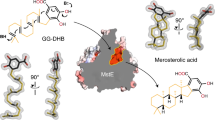Abstract
Terpene cyclization is orchestrated by terpene cyclases, which are involved in the biosynthesis of various cyclic natural products, but understanding the origin and mechanism of the selectivity of terpene cyclization is challenging. In this work, we describe an in-depth mechanistic study on cyclooctatin biosynthesis by means of theoretical calculations combined with experimental methods. We show that the main framework of cyclooctatin is formed through domino-type carbocation transportation along the terpene chain, which we call a “cation-stitching cascade”, including multiple hydrogen-shifts and a ring rearrangement that elegantly determine the stereoselectivity.
Similar content being viewed by others
Introduction
Terpenoids or isoprenoids are a large and highly diverse group of natural products; over 55,000 terpenoids with a wide range of chemical structures (including monocyclic or multi-cyclic fused ring structures) and various biological activities have been reported to date1. This structural diversity is generated in the course of the cyclization reactions catalyzed by terpene cyclases, which provide remarkable examples of exquisite enzymatic control of the course of a chemical reaction cascade2,3,4.
We have established that CotB2, a diterpene cyclase5 identified in a soil-living filamentous bacterium Streptomyces melanosprofaciens, provides an especially elegant example of synthetic virtuosity and stereochemical control; CotB2 synthesizes the characteristic 5-8-5 fused ring system of cyclooctat-9-en-7-ol (PD), containing six chiral carbons, by cyclizing the achiral and acyclic C20 substrate (SM), geranylgeranyldiphosphate (GGDP)5. Among various diterpene cyclases, CotB2 specifically produces PD as a single product with the correct C–C bond connectivity and stereochemistry. Thus, CotB2 appears to precisely pre-organize the conformation of SM, control the conformations of all reactive intermediates and properly regulate the reactivities of the cation intermediates in its active site pocket.
We previously proposed the mechanism of the CotB2-catalyzed reaction cascade (Fig. 1), based on a powerful combination of in vivo tracer experiments using uniformly 13C-labeled glucose and in vitro reactions of regiospecifically 2H-substituted SM6. The reaction cascade is divided into three parts, ring skeleton construction (Part A), hydrogen migrations (Part B) and carbon–carbon backbone rearrangement (Part C). Part A begins with CotB2-catalyzed dissociation of the pyrophosphate group followed by initial cyclization to produce a cation intermediate with a bicyclic 5–11 fused-ring skeleton. Subsequent 1,5-hydrogen-transfer from C8 to C15 provides an allylic cation, which undergoes intramolecular cyclization reaction with the C2-C3 olefin to form a cationic intermediate bearing the tricyclic 5-8-5 fused-ring system. The second part (Part B, Fig. 1) involves long-range cation transfer via multiple hydrogen shifts. The cationic intermediate likely undergoes a 1,3-H shift from C6 to C3 and a successive 1,5-H shift from C10 to C6 to generate the homoallylic cation. In Part C, formation of the cyclopropylcarbinyl cation, which features a C8–C9–C10 cyclopropyl ring, is followed by interconversion of cyclopropylcarbinyl cations. Finally, C7–C8 ring opening with capture of water by the homoallylic cation results in the formation of PD. Although our previous isotope tracing experiments and NMR spectroscopic investigations demonstrated the presence of the unusual carbon–carbon bond rearrangement, less is known about other intermediates and the mechanisms of other reactions on the pathway to the final product. For instance, in Part B, an alternative cascade involving two successive non-concerted 1,2-H shifts, firstly C2 to C3 yielding a cation at C2, then C6 to C2, could not be excluded in the previous work. Recent advances in theoretical methods, coupled with the enormous increase in available computational power, have enabled chemists to calculate transition structures and reaction pathways for complex molecules7,8,9,10. Density functional theory (DFT) combined with the AFIR (artificial force induced reaction) method and Reaction Plus method was employed herein to corroborate the experimental results and to comprehensively unveil this biosynthetic pathway.
All calculations were carried out at the M062X/6-31G** level11 using Gaussian 0912, GRRM1113 and Reaction Plus14 programs. The full reaction pathway for the conversion of geranylgeranyl diphosphate (GGDP: SM) to cyclooctat-9-en-7-ol (PD) and the energy diagram are presented in Figs 2 and 3, respectively. We will first discuss the CotB2-mediated carbocation formation and successive tricyclic skeleton construction part (Part A). Dissociation of the pyrophosphate of SM yields an allylic carbocation (IM1) partially stabilized by a cation-π interaction with a distal C10–C11 double bond15. Cation-mediated annulation proceeds smoothly to form a bicyclic intermediate (IM2), which undergoes sequential conformational change16 to give a more stable intermediate (IM3) with an activation energy of 12.2 kcal/mol. IM3 contains two non-equivalent hydrogens at the C8 carbon atom. The α-hydrogen (downward) atom of the two hydrogens can migrate smoothly17 along the intrinsic reaction coordinate to the C15 carbocation with 6.6 kcal/mol stabilization energy for formation of the more stable allylic cation (IM4). TS_3-4 is conformationally more favorable than TS_3-4β (1,5-β–H shift) by ca. 40 kcal/mol. The second annulation then occurs smoothly with an activation barrier of 5.5 kcal/mol to form the 5-8-5 fused-ring skeleton (IM5) with a large stabilization energy (ΔG = 13.3 kcal/mol). The overall gain to construct the tricyclic structure IM5 is rather large (–25.5 kcal/mol from IM1). In Part B, multiple hydrogen shifts occur successively (IM5→IM6→IM7→IM8→IM9), leading to long-range cation transfer18. After the tandem 1,2–H shifts (IM5→IM7) on the C-ring to yield a new allylic cation (the reaction pathway is discussed in detail below), a 1,5–H shift across the B-ring gives a homoallylic cation intermediate (IM9). As for Part C, DFT calculations of the C8–C9 bond rearrangement process were essentially consistent with our previously proposed reaction mechanism based on isotope tracing experiments and NMR spectroscopic investigations. After the conformational change of IM9 into IM10 with a very small activation barrier, the C7–C8 π bond of the homoallylic cation in IM10 approaches the cation centre to form a cyclopropylcarbinyl cation intermediate (IM11) with an unexpectedly large stabilization energy (ΔG = –11.4 kcal/mol). IM11 has a highly distorted cyclopropane ring in which participation of the elongated C8–C10 σ orbital partially contributes to stabilization of the neighboring C7 carbocation, as judged from the elongation of the C8–C10 bond (1.67 Å) as well as the short C7–C8 bond (1.38 Å)19. An unusual C–C bond rearrangement then takes place via a unique bicyclobutonium cation20 transition state (TS_11-12) with very low activation energy (6.5 kcal/mol) to give another cyclopropylcarbinyl cation (IM12). IM12 is energetically more stable than IM11 by 4.3 kcal/mol owing to the strain magnitudes of their cyclopropane rings. Finally, a hydration reaction yields the final product (PD). Although we should keep in mind the possibility that the CotB2 may be involved in the final step, our preliminary calculations indicate that non-enzymatic hydration of IM12 with water molecules would also be likely to proceed smoothly to provide PD.
The energy diagram (Fig. 3) immediately suggests that this is a thermodynamically and kinetically favorable biosynthetic reaction cascade: 1) activation barriers are all low enough for the reactions to proceed smoothly at ambient temperature, 2) the entire energy profile descends as the reactions proceed and 3) the overall exothermicity is very large21. The first annulation and conformational change (IM2→TS_2-3) is the rate-determining step. Remarkably, the cyclopropane ring formation and carbon–carbon bond rearrangement each require much lower activation energy than this step.
We next studied in detail the 1,3-cation shift reaction mechanism (IM5→IM7), which is the last puzzle in the biosynthesis. Two pathways are possible, i.e., direct 1,3-hydrogen shift and sequential double 1,2-hydrogen shift (Fig. 4). We would expect a priori that the concerted 1,3-H shift is a reasonable route, because of the stereoselectivity and step-economy and so it was found. The 1,3-H shift from the C6 to the C3 position takes place as a single event with an overall energy loss of 20.7 kcal/mol. We could also identify the TSs for the two successive non-concerted 1,2-H shifts: the first 1,2-H shift from the C2 to C3 via TS_5-6 yielding IM6 followed by the second one from C6 to C2 via TS_6-7 generating an allyl cation IM7. The activation energies for the first and second 1,2-H shifts are 7.1 kcal/mol and only 1.5 kcal/mol, respectively. The more than 10 kcal/mol difference of energy between the 1,3- and the tandem 1,2-transfer translates into an over 1010-fold difference of reaction rate at room temperature; hence the sequential double 1,2-hydrogen shift should predominate over direct 1,3-hydrogen shift in the microorganism.
To validate the successive 1,2-hydrogen migrations suggested by our calculation, we next incubated recombinant CotB26 individually with two regiospecifically deuterated GGDPs, 2D- and 6D-GGDP (which were successfully prepared with >99% D incorporation ratio via the multistep procedure shown in Fig. 5 and characterized by means of high-resolution mass analysis and NMR spectroscopy as shown in the SI). Comparison of the deuterated product generated in each reaction by means of 1H NMR spectroscopy with natural abundance 2 (Fig. S1–S2) allowed assignment of the positions of deuteration in each product, thereby establishing that 2D- and 6D-GGDP were converted to 3D- and 2D-PD, respectively (Fig. 6). The formation of 3D- and 2D-PD from 2D- and 6D-GGDP, respectively, is fully consistent with the occurrence of successive 1,2-hydrogen migrations from C2 to C3 and C3 to C6 during the cyclization reaction cascade.
Regioselective synthesis of the deuterated GGDPs.
(A) Reaction conditions: (a) LiAlD4 (1.0 equiv.), Et2O, −60 °C, 0.5 h; (b) EtO2C–C(CH3) = PPh3 (1.2 equiv.), CH2Cl2, rt, 1 h; (c) LiAlH4 (1.5 equiv.), Et2O, −40 to −20 °C, 1 h; (d) CBr4 (1.3 equiv.), PPh3 (1.3 equiv.), CH2Cl2 rt, 0.5 h; (e) Sulfone-A (1.5 equiv.), t-BuOK (4.0 equiv.), THF, −20 °C, 1 h; (f) TBAF (4.0 equiv.), THF, rt, 3 h; (g) LiBHEt3 (5.0 equiv.), Pd(dppp)Cl2 (5.0 mol%), THF, 0 °C, 1 h. (B) Reaction conditions: (a) PCC (2.0 equiv.), CH2Cl2, rt, 3 h; (b) EtO2C–C(CH3) = PPh3 (1.2 equiv.), CH2Cl2, rt, 2 h; (c) LiAlH4 (1.5 equiv.), Et2O, −40 to −20 °C, 1 h; (d) CBr4 (1.3 equiv.), PPh3 (1.3 equiv.), CH2Cl2 rt, 0.5 h; (e) Sulfone-B (1.5 equiv.), t-BuOK (4.0 equiv.), THF, −20 °C, 1 h; (f) TBAF (4.0 equiv.), THF, rt, 3 h; (g) LiBHEt3 (5.0 equiv.), Pd(dppp)Cl2 (5.0 mol%), THF, 0 °C, 2 h.
In summary, our computational and experimental studies have clarified the whole biosynthetic route to cyclooctatin. DFT calculations reveal that the core framework of cyclooctatin is constructed via tandem carbocation transfer (“cation-stitching cascade”), involving several hydrogen-shifts as well as cyclopropylcarbinyl cation rearrangement. Such a reaction cascade provides high efficiency and selectivity and is well supported by the results of the deuteration experiments. Thus, the combination of theoretical calculations and experimental studies has provided detailed insight into this biosynthetic mechanism. This approach may also throw light on the evolution of particular biosynthetic pathways and provide clues for designing new synthetic routes for complex functional molecules.
Methods
All calculations were performed with the Gaussian 09 program12. Geometry optimizations were performed in the gas phase at the M062X/6-31G** level11, without any symmetry restrictions and the nature of the minima was verified by frequency calculations within the harmonic approximation. IRC for all TS was performed with GRRM1113 and/or Reaction Plus14 programs based on Gaussian 09. Gibbs free energy was used as the basis for discussion in this study. The Cartesian coordinates of all species are collected in Supporting Information. Details for the synthesis of deuterated GGDPs and the corresponding deuterium tracing experiments are described in Supporting Information as well.
Additional Information
How to cite this article: Sato, H. et al. "Cation-Stitching Cascade": exquisite control of terpene cyclization in cyclooctatin biosynthesis. Sci. Rep. 5, 18471; doi: 10.1038/srep18471 (2015).
References
Christianson, D. W. Structural Biology and Chemistry of the Terpenoid Cyclases. Chem. Rev. 106, 3412–1442 (2006).
Zhang, Q. & Tiefenbacher, K . Terpene cyclization catalysed inside a self-assembled cavity, Nat. Chem. 7, 197–202 (2015).
Pronin, S. V. & Shenvi, R. A. Synthesis of highly strained terpenes by non-stop tail-to-head polycyclization, Nat. Chem. 4, 915–920 (2012).
Smanski, M. J., Peterson, R. M., Huang, S. X. & Shen, B. Bacterial Diterpene Synthases: New Opportunities for Mechanistic Enzymology and Engineered Biosynthesis. Curr Opin Chem Biol. 16, 132–141 (2012).
Kim, S. Y. et al. Cloning and heterologous expression of the cyclooctatin biosynthetic gene cluster afford a diterpene cyclase and two P450 hydroxylases. Chem. Biol. 16, 736 – 743 (2009).
Meguro, A. et al. An Unusual Terpene Cyclization Mechanism Involving a Carbon–Carbon Bond Rearrangement. Angew. Chem. Int. Ed. 54, 4353–4356 (2015).
Tantillo, D. J. Walking in the woods with quantum chemistry–application of quantum chemical calculations in natural products research. Nat. Prod. Rep. 30, 1079–1086 (2013).
Tantillo, D. J. Biosynthesis via carbocations; Theoretical studies on terpene formation. Nat. Prod. Rep. 28, 1035–1053 (2011).
Hong, Y. J. & Tantillo, D. J. A potential energy surface bifurcation in terpene biosynthesis, Nat. Chem. 1, 384–389 (2009).
Hong, Y. J. & Tantillo, D. J. Biosynthetic consequence of multiple sequential post-transition-state bifurcations, Nat. Chem. 6, 104–111 (2014).
Zhao, Y. & Truhlar, D. G. The M06 suite of density functionals for main group thermochemistry, thermochemical kinetics, noncovalent interactions, excited states and transition elements: two new functional and systematic testing of four M06-class functionals and 12 other functionals. Theor. Chem. Acc. 120, 215–241 (2008).
Frisch, M. J. et al. Gaussian 09 Revision D.01, Gaussian, Inc., Wallingford CT. Full citations are given in supporting information.
Maeda, S., Osada, Y., Morokuma, K. & Ohno, K. GRRM11, Version 11.03. Full citations are given in supporting information.
Cossi, M. & Barone, V. Solvent effect on vertical electronic transitions by the polarizable continuum model. J. Chem. Phys. 112, 2427–2435 (2000).
Concomitant C–Ring Expansion and D–Ring Formation in Lanosterol Biosynthesis from Squalene without Violation of Markovnikov’s Rule. J. Am. Chem. Soc. 124, 10286–10287 (2002).
Chiba, R., Minami, A., Gomi, K. & Oikawa, H. Identification of Ophiobolin F Synthase by a Genome Mining Approach:A Sesterterpene Synthase from Aspergillus clavatus. Org. Lett. 15, 594–597 (2013).
Hong, Y. J. & Tantillo, D. J. Feasibility of Intramolecular Proton Transfers in Terpene Biosynthesis – Guiding Principles. J. Am. Chem. Soc. 137, 4134–4140 (2015).
Olah, G. A., Kelly, D. P., Jeuell, C. L. & Porter, R. D. Stable Carbonium Ions. XCVIII. The Nonclassical Cyclopropylcarbinyl Cation. J. Am. Chem. Soc. 92, 2544–2546 (1970).
Hong, Y. J., Giner, J. L. & Tantillo, D. J. Bicyclobutonium Ions in Biosynthesis – Interconversion of Cyclopropyl-Containing Sterols from Orchids. J. Am. Chem. Soc. 137, 2085–2088 (2015).
Wendt, K. U., Poralla, K. & Schulz, G. E. Structure and Function of a Squalene Cyclase. Science 277, 1811–1815 (1997).
Hong, Y. J. & Tantillo, D. J. The energetic viability of an unexpected skeletal rearrangement in cyclooctatin biosynthesis. Org. Biomol. Chem., 13, 10273–12738 (2015).
Acknowledgements
This work was supported by JSPS KAKENHI (S) (No. 24229011) (to M.U.) and JSPS KAKENHI (B) (No. 26292058) (to T.K.). Allotment of computational resources (Project G14001 and G15011) from RICC (RIKEN Integrated Cluster of Clusters) and HOKUSAI GreatWave (RIKEN) is gratefully acknowledged. H.S. is grateful for a scholarship provided by the Junior Research Associate Program (RIKEN). C.W. is grateful for the financial support from the JSPS Tei-Soku Program (PU14008). Very recently, a similar mechanistic study was independently reported by Tantillo et al.22.
Author information
Authors and Affiliations
Contributions
H.S. performed the calculations and analysed the results with the assistance of Y.M. and N.T. K.T., M.N. and T.K. performed and analysed the deuteration experiments. K.S., S.U., Y.T. and T.S. synthesized the deuterated GGDP precursors. H.S., C.W., T.K. and M.U. discussed the results and wrote the manuscript with feedback from all authors. M.U. supervised the overall research.
Ethics declarations
Competing interests
The authors declare no competing financial interests.
Electronic supplementary material
Rights and permissions
This work is licensed under a Creative Commons Attribution 4.0 International License. The images or other third party material in this article are included in the article’s Creative Commons license, unless indicated otherwise in the credit line; if the material is not included under the Creative Commons license, users will need to obtain permission from the license holder to reproduce the material. To view a copy of this license, visit http://creativecommons.org/licenses/by/4.0/
About this article
Cite this article
Sato, H., Teramoto, K., Masumoto, Y. et al. “Cation-Stitching Cascade”: exquisite control of terpene cyclization in cyclooctatin biosynthesis. Sci Rep 5, 18471 (2016). https://doi.org/10.1038/srep18471
Received:
Accepted:
Published:
DOI: https://doi.org/10.1038/srep18471
This article is cited by
-
Towards a comprehensive understanding of the structural dynamics of a bacterial diterpene synthase during catalysis
Nature Communications (2018)
-
Theoretical Study of Sesterfisherol Biosynthesis: Computational Prediction of Key Amino Acid Residue in Terpene Synthase
Scientific Reports (2018)
-
Biosynthetic studies on terpenoids produced by Streptomyces
The Journal of Antibiotics (2017)
Comments
By submitting a comment you agree to abide by our Terms and Community Guidelines. If you find something abusive or that does not comply with our terms or guidelines please flag it as inappropriate.









